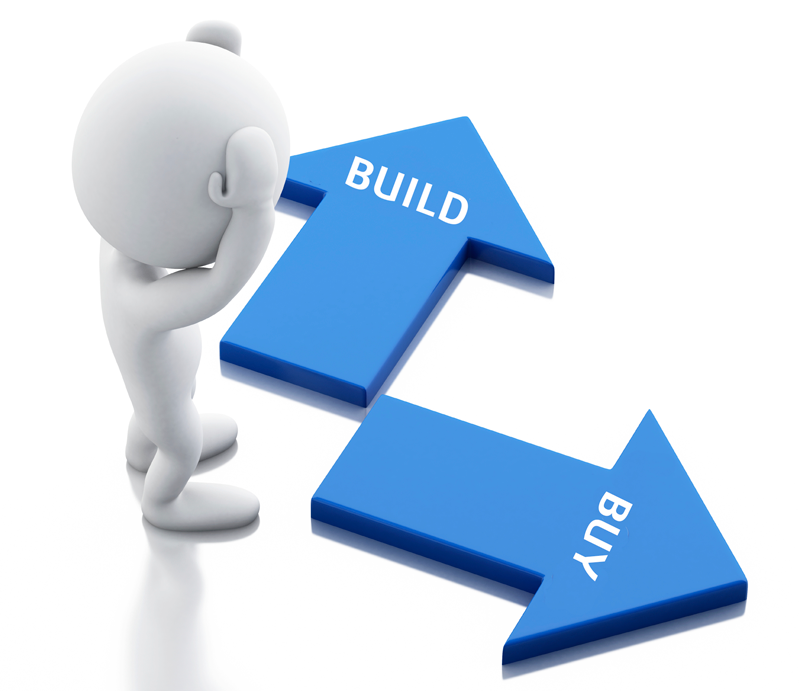Make or buy is an age old question for anyone building products, whether hardware or software. For example, for a manufacturer, does it make sense to buy a pre-built assembly or design and build their own? The same question arises for software developers: take advantage of existing SDKs to solve a particular problem or write custom code. And unfortunately, the answer always is “it depends.”
Where is Your Value-Add?
The make-or-buy decision often boils down to determining what your company or team’s value-add is. Should your company invest both the time and effort in duplicating what may already be available off the shelf? Does the value of having a home-grown solution exceed the cost or a potential lack of product completeness? Or should the focus be spent on developing custom solutions unavailable elsewhere that can add differentiation to your product?
For companies involved in providing solutions requiring 3D modeling, the answer may come down to whether 3D modeling is the focus of what they deliver or an add-on to a larger product. For example, a machine tool vendor’s primary focus is hardware, but manufacturing today requires 3D modeling. To complicate matters, customers expect that software needed to drive the equipment comes with the package. However, to a tool vendor, adding software development to the mix introduces technical challenges. While software provides true differentiation by offering unique functionality, fully accessing all the capabilities of the equipment, it adds to delivery schedules and development costs. Leveraging the offering of a toolkit vendor can remove risk from the schedule as well as allowing the software team to focus on the user interface and connectivity to the tool — areas that can benefit greatly from their expertise.
For a standalone software vendor, the decision may be more difficult. There are two aspects to this decision: how central is the modeling engine to the solution and how important is maintaining tight control over all aspects of the solution.
In so many applications, it is not how data was generated that is important, but what is done with that data. For a vendor in the 3D-modeling space, focusing on how the model data is used and manipulated can be more important than dealing with the complexity of modeling the data. True differentiation can come in how users interact and manipulate the model.
Fear of losing control can often be a concern, but is maintaining control worth the extra expense and schedule hit, not to mention the pain of dealing with a potentially immature solution — especially when proven off-the-shelf solutions are available for integration?
Taking advantage of existing 3D-modeling toolkits can allow vendors to focus on their own IP and value-add while lowering development costs and schedule. A customer of a toolkit benefits from the experience of all other users of that toolkit.
Where Can a Toolkit Vendor Help
As a vendor of software development toolkits, Spatial delivers robust solutions tested by millions of end users over a 30 year span of time to refine, harden and industrialize. Your team benefits from the Spatial engineering team’s years of experience in dealing with 1000s of CAD databases. As a result, from a support perspective, your team does not have to deal with the usual issues when rolling out new code to customers. Moreover, due to the maturity and robustness of the solution, the amount of support issues is greatly reduced. Your customers benefit from any code fixes and improvements needed by the Spatial community.
Spatial can help your team in multiple areas.
Modeling
Using the Spatial 3D Modeling Software development toolkit, developers can focus their efforts on delivering unique product capabilities, rather than basic application infrastructure and standard functions. The SDK provides:
- Complete set of modeling operators including direct editing and history to support the most demanding modeling requirements
- Extensible options to target specific industrial challenges such as pressed-metal tooling, analysis small feature removal and 2D/3D constraint management
- Thread safe, enabling multi-threaded cloud based or desktop applications
- Feature recognition capabilities to simplify models for analysis, for IP protection, or to employ search techniques that improve part reusability
- Polygonal mesh generation supporting a variety of uses including additive manufacturing, visualization, analysis, and tool path simulation
Visualization
Visualization software allows you to satisfy users’ needs to visualize ideas, verify designs, and create virtual prototypes. HOOPS Visualize is the industry’s most powerful, portable and complete graphics development component for creating or enhancing 3D applications. HOOPS Visualize helps developers accelerate the development of high-performance 3D applications for desktop, cloud, and mobile applications using the high-level graphics APIs that power applications across a range of industries.
Interoperability
No solution is an island these days. The ability to correctly import, manipulate and export data is crucial in the world of 3D modeling. Moreover, problems associated with data translation may not become apparent until later in the design process when investigation and correction of problems is more difficult, more costly and requires more investigation. Therefore, a robust translation process is needed.
3D InterOp translates solid (BREP), wire, surface, free surfaces, free curves, and free points. Advanced modeling technology is used in each of the translators to address common data translation differences including: geometry repair, topology repair and tolerance resolution. Your customers can benefit from Spatial’s 30 years of experience in handling databases.
Successfully developing, deploying, and supporting 3D applications is a substantial challenge, requiring significant investment, precise execution, and focus on innovation and differentiation. Using 3D software development kits can shorten development time and risk, as well reduce cost and improve the robustness of your solution.



















